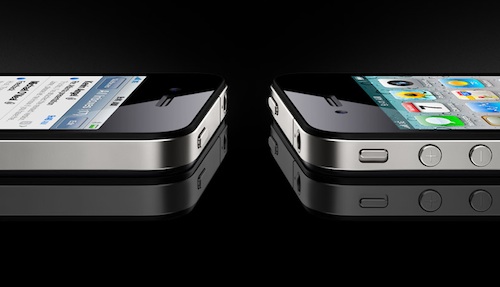 The first thing one notices when picking up the iPhone 4 for the first time is its slick design. Pictures don’t do it justice. Apple has gone for a minimalist look with its new smartphone. It’s a bit like the step up from the old, bubble-shaped iMacs to the modern, integrated, liquid crystal display-based machines they are today.
The first thing one notices when picking up the iPhone 4 for the first time is its slick design. Pictures don’t do it justice. Apple has gone for a minimalist look with its new smartphone. It’s a bit like the step up from the old, bubble-shaped iMacs to the modern, integrated, liquid crystal display-based machines they are today.
The second thing that immediately grabs the attention is the stunning, 640×960-pixel display. We’ve never seen something so bright and clear on a mobile handset. Apple, always with an eye to marketing, calls it the “Retina Display”. When we placed the Apple next to a brand-new HTC Desire, both devices with their brightness settings maximised, the quality of the iPhone’s screen really stood out.
The iPhone 4’s incredibly high pixel density — 326 pixels per inch — makes fonts look smooth at any size. For now, there’s no doubt that the iPhone 4’s screen leads its rivals in every way.
The third facet of the iPhone 4 that is immediately apparent is its speed. iOS4 — our test unit from Wantitall.co.za was running the updated 4.0.1 version — runs like greased lightning. The phone uses the same A4 processor that powers the bigger iPad tablet device. After using the iPhone 4, you’ll find the older-generation iPhones, even the 3GS, glacial by comparison.
At 137g it’s perhaps slightly on the heavy side compared to some modern smartphones, like the new Samsung Wave. But the iPhone 4 has the most solid build of the series so far, and that’s saying something for a series of phones that has never been anything other than solid.
There’s actually very little to fault the iPhone on, other than the antenna problem (which we’ll get to shortly). The quality of the 5-megapixel camera is superb, and video shooting in up to 720p high-definition resolution is smooth and fast.
“Facetime” video calling is fun, though we fail to see why it only works in Wi-Fi hotspots. Given the low-resolution of the front-facing camera, surely Apple could have offered the service over 3G networks, too. Perhaps America’s cellular networks, already buckling under load of data consumed by iPhone users, wouldn’t have been able to cope with the extra traffic.
The internal speaker has also been improved over earlier version. We played back a podcast loudly and clearly, with zero distortion.
Apple claims the battery life has improved over the 3GS, with some reviewers getting reporting it’s gone up by about 40%. Unfortunately, we didn’t have enough time with the device to test this aspect properly.
All in all, though, the iPhone 4 is easily the best smartphone that Apple has made to date. And it is one of the very best handset choices in the market today.
Except for one thing. And it’s a big thing: the now-infamous external antenna. As you’ll know doubt be aware, some iPhone 4 users have complained that their signal cuts out when they hold their handset in a particular way, causing their calls to drop or their Web browsing on 3G to be interrupted.
So many users began complaining, in fact, that Apple CEO Steve Jobs was forced to call a press conference earlier this week to try to placate growing anger from consumers.
Jobs came out guns blazing, saying all smartphones suffer the same reception problems to varying degrees. And, in what we think was a big PR mistake, he named some of the handsets, prompting understandably angry reactions from companies such as Research in Motion, Nokia and Samsung.
In our brief tests, we found that blocking the antenna on the lower-half of the phone causes a severe degradation in signal strength.
Gripping its lower half in our left hand, as many people do when checking their e-mail or browsing the Web, the signal strength (on MTN) dropped from four bars to just one bar. As soon as we let go of the device, the signal returned to four bars.
We weren’t able to replicate the loss in signal quality on an HTC Desire, though we also clasped our hands tightly around the rival handset, both at the top of the phone and the bottom.
Apple’s solution to the problem is to give away a “bumper” case, so as to stop you from touching the antenna in the wrong place. The solution seems like a kludge to us.
Is it a deal-breaker problem? Probably not, especially if you’re already a big fan of the iPhone. However, for many people, this reviewer included, it’s enough of a problem to hold off on a purchasing decision until Apple has fixed it.
Whatever Jobs says, the antenna problem is a hardware design flaw. Form simply beat function. Apple is a great company with great products. But, like everyone, it is capable of making a mistake. In the end, of course, it’s how it deals with the mistake that really matters. — Duncan McLeod, TechCentral
- Vodacom is expected to begin selling the iPhone 4 in September. MTN will probably also offer the handset, though it hasn’t said anything officially yet
- Subscribe to our free daily newsletter
- Follow us on Twitter or on Facebook




